 |
 |
| |
The Range of Indigenous Science
|
|
| |
The range of Native Science is enormous. It is defined by the experiential expertise, academic expertise, cultural affiliation, geographic location, and intentions of the people involved. But always, Native science involves Native persons learning about and understanding the natural world (or non-Native persons learning about and understanding the natural world in the same ways Native people do). Like Western science, Native science is about both a specific body of knowledge and the processes used to obtain and pass on that knowledge. Some examples include:
- Aleutian Island Natives who study changes in the populations of food animals they hunt and levels of contaminants in such foods, and who then log this information into a networked database shared with other Arctic villagers. See, for example, pages about this subject on the home page of the Alaska Native Science Commission.
- Native persons with advanced degrees in science who include traditional knowledge in their work. There are many examples, from a Native university professor who studies indigenous agricultural systems to learn methods that can be applied to help solve contemporary crises in agricultural productivity worldwide, to a Native geologist working for the United States Geological Survey who incorporates Native knowledge into her research.
- Western-trained science educators with traditional cultural upbringings who create new Native-based science curricula for K-12 Native students -- to which both Native and mainstream American students respond with higher scores on science tests, and greater interest in science in general. See, for an example, pages at the website for the Alaska Rural Systemic Initiative.
- A traditional elder skilled in highly specialized knowledge of local plants and their medicinal uses who continues to study those plants and their uses, and who teaches others the knowledge of how to identify, evaluate, collect, store, and prepare their various parts appropriately.
- Note: Much of this information is being investigated and recorded by Western scientists from archeology, botany, and medicine. The engagement of pharmaceutical companies in the mix -- sometimes to the extent of coming back to native healers with injunctions against further use of the natural substances they shared knowledge of, because of patents the company has filed -- are making this area a hotbed of political activism and worldwide efforts to establish policy and legislation. See, for example, pages on ethnobotany on university and other websites.
- Ancient knowledge about the natural world and the tools or other implements designed to study specific processes and make testable predictions about them -- including sites such as the "Sun Dagger" of Chaco Canyon. These kinds of data have primarily been studied in the Western science disciplines of archeoastronomy, and archeology in general. For many examples, see the book Encyclopedia of American Indian Contributions to the World: 15,000 Years of Inventions and Innovations. (Emory Dean Keoke and Kay Marie Porterfield, 2002).
- Traditional oral knowledge that records reliable data about climate, animal and plant distributions, and astronomical events of the past.
- Note: These data are presently being diligently sought after and recorded by Western scientists working, for example, on climate change in the Arctic. That has led to political and social difficulties with indigenous persons who find themselves being "mined" (via interview) for data that are then used in studies that don't cite them as sources for the data and, at the same time, marginalize their expertise as non-scientific and therefore irrelevant to solving climate-based problems afflicting the area. See the Principles for Conducting Research page of NSF's Office of Polar Programs, and compare it to the Research Ethics page of the Alaska Native Science Commission.
- Programs for scientists-in-training that help them learn how to succeed as scientists without surrendering their cultural heritage and worldview. See, for example, the SOARS Program at the National Center for Atmospheric Research.
The Range of Indigenous Science
The Processes of Indigenous Science
Why Should We Explore, Explain, Acknowledge, or Promote Indigenous Science
A Brief History of Indigenous Science
Additional Resources on Indigenous Science
|
|
|
|
|
|
 |
|
|

